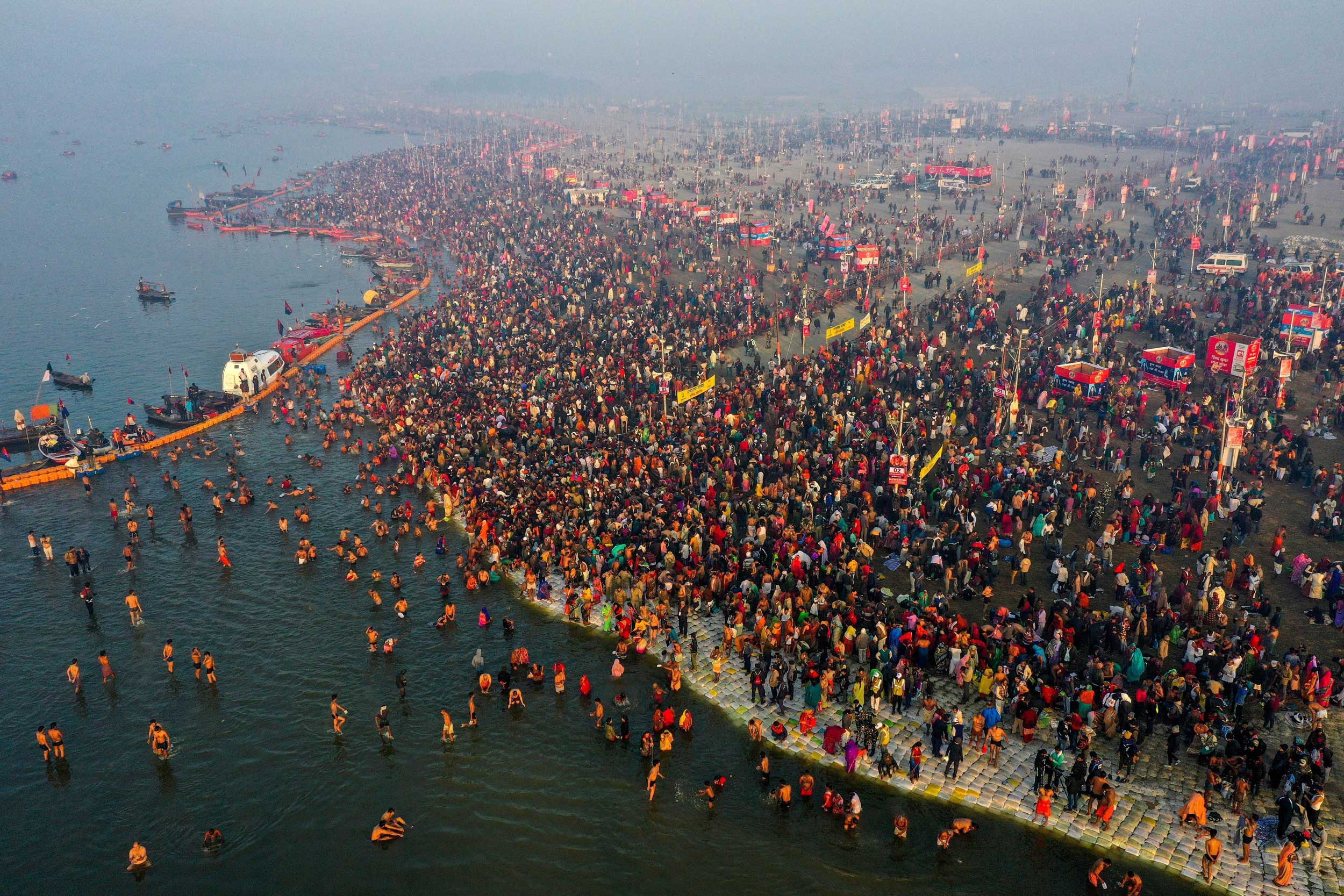Kumbh Mela or Kumbha Mela (/ˌkʊmb ˈmeɪlə/) is a major pilgrimage and festival in Hinduism. It is celebrated in a cycle of approximately 12 years, to celebrate every revolution Brihaspati (Jupiter) completes, at four river-bank pilgrimage sites: Prayagraj (Ganges-Yamuna-Sarasvati rivers confluence), Haridwar (Ganges), Nashik (Godavari), and Ujjain (Shipra).The festival is marked by a ritual dip in the waters, but it is also a celebration of community commerce with numerous fairs, education, religious discourses by saints, mass gatherings of monks, and entertainment. The seekers believe that bathing in these rivers is a means to prāyaścitta (atonement, penance) for past mistakes, and that it cleanses them of their sins.
The festival is traditionally credited to the 8th-century Hindu philosopher and saint Adi Shankara, as a part of his efforts to start major Hindu gatherings for philosophical discussions and debates along with Hindu monasteries across the Indian subcontinent. However, there is no historical literary evidence of these mass pilgrimages called “Kumbha Mela” prior to the 19th century. There is ample evidence in historical manuscripts and inscriptions of an annual Magha Mela in Hinduism – with periodic larger gatherings after 6 or 12 years – where pilgrims gathered in massive numbers and where one of the rituals included a sacred dip in a river or holy tank. According to Kama MacLean, the socio-political developments during the colonial era and a reaction to Orientalism led to the rebranding and remobilisation of the ancient Magha Mela as the modern era Kumbh Mela, particularly after the Indian Rebellion of 1857.
The weeks over which the festival is observed cycle at each site approximately once every 12 years based on the Hindu luni-solar calendar and the relative astrological positions of Jupiter, the sun and the moon. The difference in Prayag and Haridwar festivals is about 6 years, and both feature a Maha (major) and Ardha (half) Kumbh Melas. The exact years – particularly for the Kumbh Melas at Ujjain and Nashik – have been a subject of dispute in the 20th century. The Nashik and Ujjain festivals have been celebrated in the same year or one year apart, typically about 3 years after the Allahabad / Prayagraj Kumbh Mela. Elsewhere in many parts of India, similar but smaller community pilgrimage and bathing festivals are called the Magha Mela, Makar Mela or equivalent. For example, in Tamil Nadu, the Magha Mela with water-dip ritual is a festival of antiquity. This festival is held at the Mahamaham tank (near Kaveri river) every 12 years at Kumbakonam, attracts millions of South Indian Hindus and has been described as the Tamil Kumbh Mela. Other places where the Magha-Mela or Makar-Mela bathing pilgrimage and fairs have been called Kumbh Mela include Kurukshetra, Sonipat,and Panauti (Nepal).
The Kumbh Melas have three dates around which the significant majority of pilgrims participate, while the festival itself lasts between oneand three months around these dates. Each festival attracts millions, with the largest gathering at the Prayag Kumbh Mela and the second largest at Haridwar. According to the Encyclopædia Britannica and Indian authorities, more than 200 million Hindus gathered for the Kumbh Mela in 2019, including 50 million on the festival’s most crowded day. The festival is one of the largest peaceful gatherings in the world, and considered as the “world’s largest congregation of religious pilgrims”. It has been inscribed on the UNESCO’s Representative List of Intangible Cultural Heritage of Humanity. The festival is observed over many days, with the day of Amavasya attracting the largest number on a single day. The Kumbh Mela authorities said that the largest one-day attendance at the Kumbh Mela was 30 million on 10 February 2013, and 50 million on 4 February 2019.
Etymology and nomenclature
The Kumbha in Kumbha Mela literally means “pitcher, jar, pot” in Sanskrit.It is found in the Vedic texts, in this sense, often in the context of holding water or in mythical legends about the nectar of immortality. The word Kumbha or its derivatives are found in the Rigveda (1500–1200 BCE), for example, in verse 10.89.7; verse 19.16 of the Yajurveda, verse 6.3 of Samaveda, verse 19.53.3 of the Atharvaveda, and other Vedic and post-Vedic ancient Sanskrit literature. In astrological texts, the term also refers to the zodiac sign of Aquarius. The astrological etymology dates to late 1st-millennium CE, likely influenced by Greek zodiac ideas.
The word mela means “unite, join, meet, move together, assembly, junction” in Sanskrit, particularly in the context of fairs, community celebration. This word too is found in the Rigveda and other ancient Hindu texts. Thus, Kumbh Mela means an “assembly, meet, union” around “water or nectar of immortality”.
A pot (Kumbh) containing Amrita was one of the creative product of the Samudra manthan legend in ancient Hindu texts.
Large crowds at the Ganga (Ganges) on a major bathing day in the 2019 Kumbh Mela
Mythology
Many Hindus believe that the Kumbh Mela originated in times immemorial and is attested in the Hindu mythology about Samudra manthan (lit. churning of the ocean) found in the Vedic texts. Historians, in contrast, reject these claims as none of the ancient or medieval era texts that mention the Samudra Manthan legend ever link it to a “mela” or festival. According to Giorgio Bonazzoli – a scholar of Sanskrit Puranas, these are anachronistic explanations, an adaptation of early legends to a later practice by a “small circle of adherents” who have sought roots of a highly popular pilgrimage and festival.
The first page of Prayag Snana Vidhi manuscript (Sanskrit, Devanagari script). It describes methods to complete a bathing pilgrimage at Prayag. The manuscript (1674 CE) has a colophon, which states “Copied by Sarvottama, son of Vishvanatha Bhatta, Samvat 1752”.
This Hindu legend describes the creation of a “pot of amrita (nectar of immortality)” after the forces of good and evil churn the ocean of creation. The gods and demons fight over this pot, the “kumbh”, of nectar in order to gain immortality. In a later day extension to the legend, the pot is spilled at four places, and that is the origin of the four Kumbha Melas. The story varies and is inconsistent, with some stating Vishnu as Mohini avatar, others stating Dhanavantari or Garuda or Indra spilling the pot. This “spilling” and associated Kumbh Mela story is not found in the earliest mentions of the original legend of samudra manthan (churning of the ocean) such as the Vedic era texts (pre-500 BCE). Nor is this story found in the later era Puranas (3rd to 10th-century CE).
While the Kumbha Mela phrase is not found in the ancient or medieval era texts, numerous chapters and verses in Hindu texts are found about a bathing festival, the sacred junction of rivers Ganga, Yamuna and mythical Saraswati at Prayag, and pilgrimage to Prayag. These are in the form of Snana (bathe) ritual and in the form of Prayag Mahatmya (greatness of Prayag, historical tour guides in Sanskrit).
















Reviews
There are no reviews yet